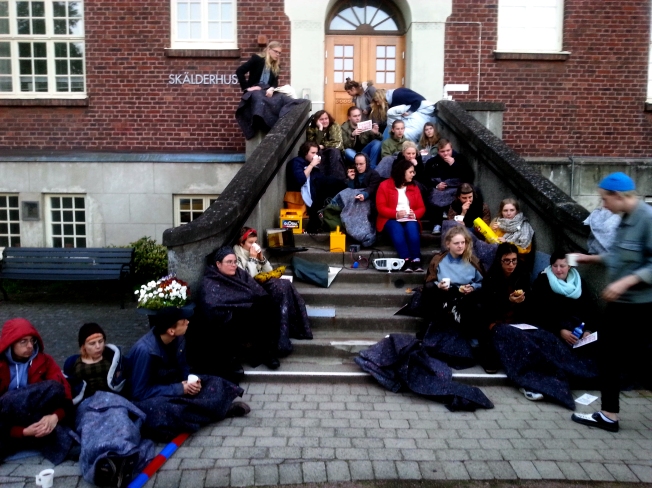We’re back at our cinema in the village Höja. On Thursday July 2:nd we’ll be screening art videos by Petra Bauer, Sandra Schäfer, Joanna Lombard, and more. The library will be open, and small comforts will be provided. Gates open at 21, free entry, all are welcome!
Stills from ‘Conversations: Stina Lundberg Dabrowski meets Petra Bauer’ by Petra Bauer
In the videowork ‘Conversations: Stina Lundberg Dabrowski meets Petra Bauer’ we see the artist Petra Bauer being interviewed by a famous Swedish reporter. Stina Lundberg Dabrowski is otherwise well known for her personal interviews with cultural celebrities and heads of state, like Margaret Thatcher and Muammar Gaddafi, for Swedish television.
“In a TV studio setting, Lundberg Dabrowski interviews Bauer about her occupation as an artist and film-maker in three consecutive live takes. In reverse chronological order, they talk about Bauer’s oeuvre. But the conversation does not stop at that. Based on her studies of British film collectives in the 1970s – such as the Berwick Street Film Collective – Bauer contrives to incorporate the films and concepts of these collectives in her own filmography. She responds to Lundberg Dabrowski’s direct address by almost consistently referring to her work with the plural pronoun “we”, as though she were constantly part, of and a representative of, a collective context.”
– Fredrik Svensk
Still from ‘Details from the Future’ by Joanna Lombard
In 2006, Joanna Lombard learned that her mother and aunt had both acted as extras in the film ‘Z’, directed by Constantin Costa-Gavras and recorded in Algeria in 1969. They had participated in scenes portraying a demonstration. Joanna Lombard looked through the film to try to identify her mother, and eventually found that all women in those scenes could potentially have been her mother. Joanna Lombard’s mother came to Sweden in 1973, and hasn’t told her daughter much about the years of her youth. There are for example no photographs preserved from those days.
In the videowork ‘Details from the Future’, Joanna Lombard scrolls through the scenes from the demonstration in the film ‘Z’, and studies the various women who participate. All the while, she recounts and comments upon her memories of her mother.
The film ‘Z’ is a fictionalised account of the actual murder of Greek opposition leader Grigoris Lambrakis. Lambrakis was murdered in 1963 by a group of right-wing extremists and military. The title of the film refers to a common Greek protest slogan; Z means “he lives”. In the beginning of the film, the head of the secret security police gives a speech in which he describes the measures taken by the right-wing government to repress and subdue any leftists, which he refers to as “sunspots”.
Still from ‘The Making Of A Demonstration’ by Sandra Schäfer
‘The Making Of A Demonstration’ by Sandra Schäfer portrays the recording of a scene in the film ‘Osama’, the first film produced in Afghanistan after the fall of the Taliban regime. During the first day of shooting, the team reconstructed a demonstration in which Afghan women had demanded the right to paid employment. Around 1000 women participated as extras in the scene. In the short video by Sandra Schäfer we see the director passing instructions to the women before their re-enactment of a demonstration which some of them possibly took part in when it happened in real life. We also see how the women receive their paychecks at the end of the day on set.










